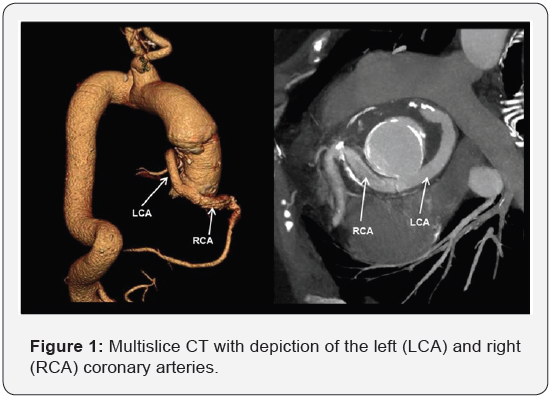Survival Three Decades after Cabrol-Operation for Aortic Aneurysm in Marfan-Syndrome-Juniper Publishers
JUNIPER PUBLISHERS-OPEN ACCESS JOURNAL OF CARDIOLOGY & CARDIOVASCULAR THERAPY
Case Report
A 68-year-old woman with Marfan syndrome presented to
our outpatient clinic. In 1984 a huge aortic root aneurysm and severe
aortic valve regurgitation were diagnosed. She underwent Cabrol-type
aortic root and aortic valve replacement with 31mm Björk-Shiley
prosthesis. Only paroxysmal atrial fibrillation was reported since
surgery. She was under therapy with beta-blocker, ACE inhibitor,
diuretic and oral anticoagulation.

The echocardiography revealed normal aortic valve
function and flow through the aortic root and arch. There was only a
mild mitral regurgitation. In order to safely exclude relevant changes
in the area of previous surgery in the ascending aorta, at the bypass
and in the coronary arteries, Multislice Computer Tomography imaging
(MS-CT) was performed. MS-CT depicted non-significant atheromatous
plaques in the coronary interposing tube graft and an ectasiaof the
ascending aorta at the distal anastomosis of the graft (Figure 1).
Cabrol-technique for aortic root and valve
replacement was first described by Cabrol et al. [1] for the treatment
of aneurysms of the ascending aorta, being mainly employed when the
tissue at the coronary ostia was very fragile or coronary arteries were
torn or tensed rendering re-implantation impossible [1,2].
During the Cabrol operation the ascending aorta is
replaced by a valved Dacron conduit. A separate Dacron interposition
tube graft is inserted, connecting the left and right coronary ostia.
This Dacron graft, is then anastomosed side-to-side to the aortic
conduit [1]. In the past decades, several modifications have been
introduced to the original version of the Cabrol approach.
Cabrol-operation was considered to offer a safe and
tension-free anastomosis when conventional re-implantation techniques
did not allow to connect the coronary arteries and the aortic conduit
[1,2]. Initially, Cabrol-procedure was demonstrated to be associated
with a 30-day mortality of 9% or less. Long-term survival rates of
48-76% during the first decade [2], and of approximately 60% at 16 years
have been reported [3]. Early mortality was higher in the first
surgery-series, probably related to a lower degree of experience.
Most common late complications were aortic dissection
and late coronary artery stenosis. Age, Marfan syndrome, cross-clamp
time and cardiopulmonary bypass duration were significant independent
risk predictors for late mortality[3]. The non-negligible coronary
complications [4] and the
emergence of the “button” technique have reduced Cabrol
indications. Cabrol-operation is currently applied as first-line
procedure only in some selected cases, or as a rescue operation
for complex aortic disease [2].
For more articles in Open Access Journal of
Cardiology & Cardiovascular Therapy please click on: https://juniperpublishers.com/jocct/index.php


Comments
Post a Comment